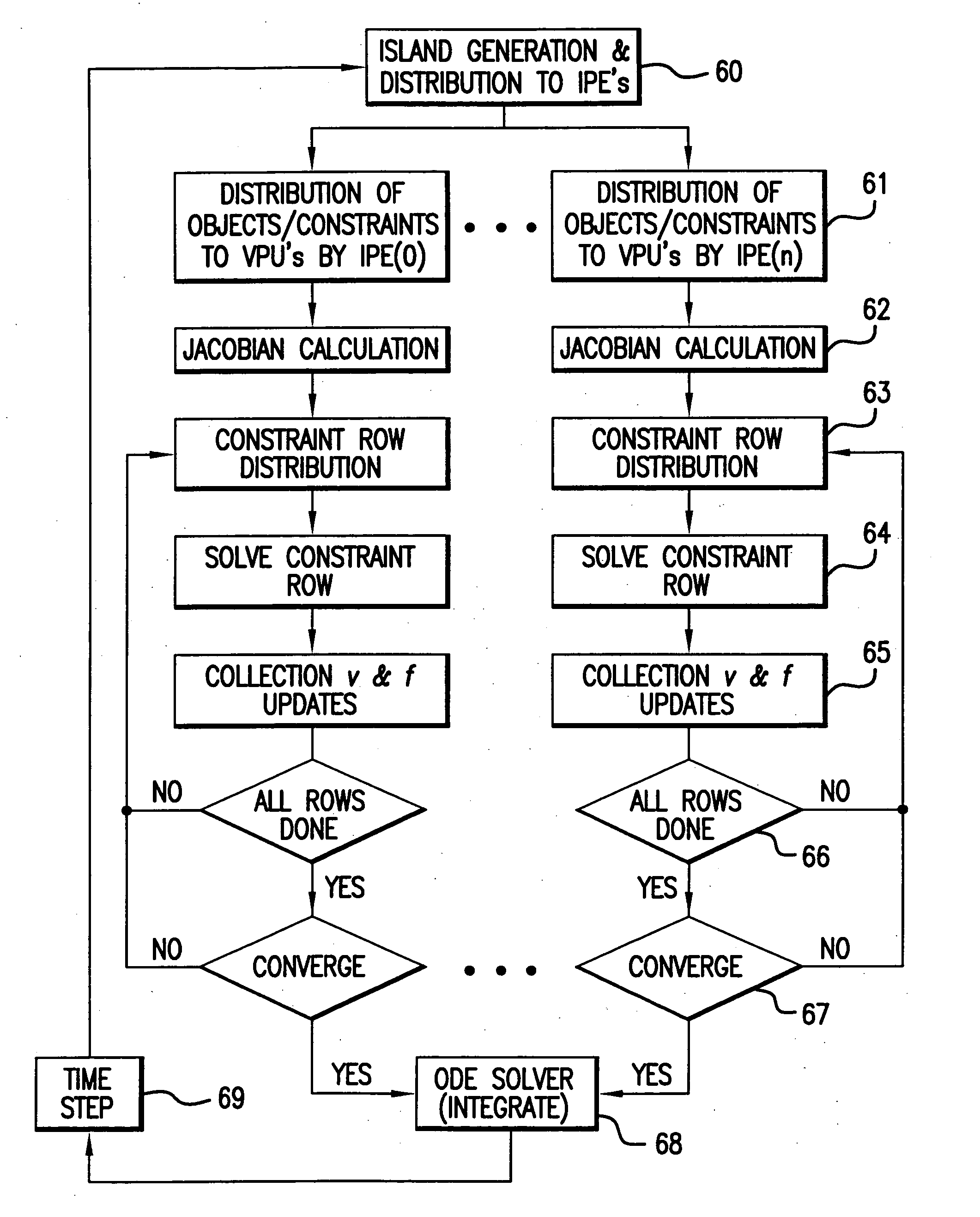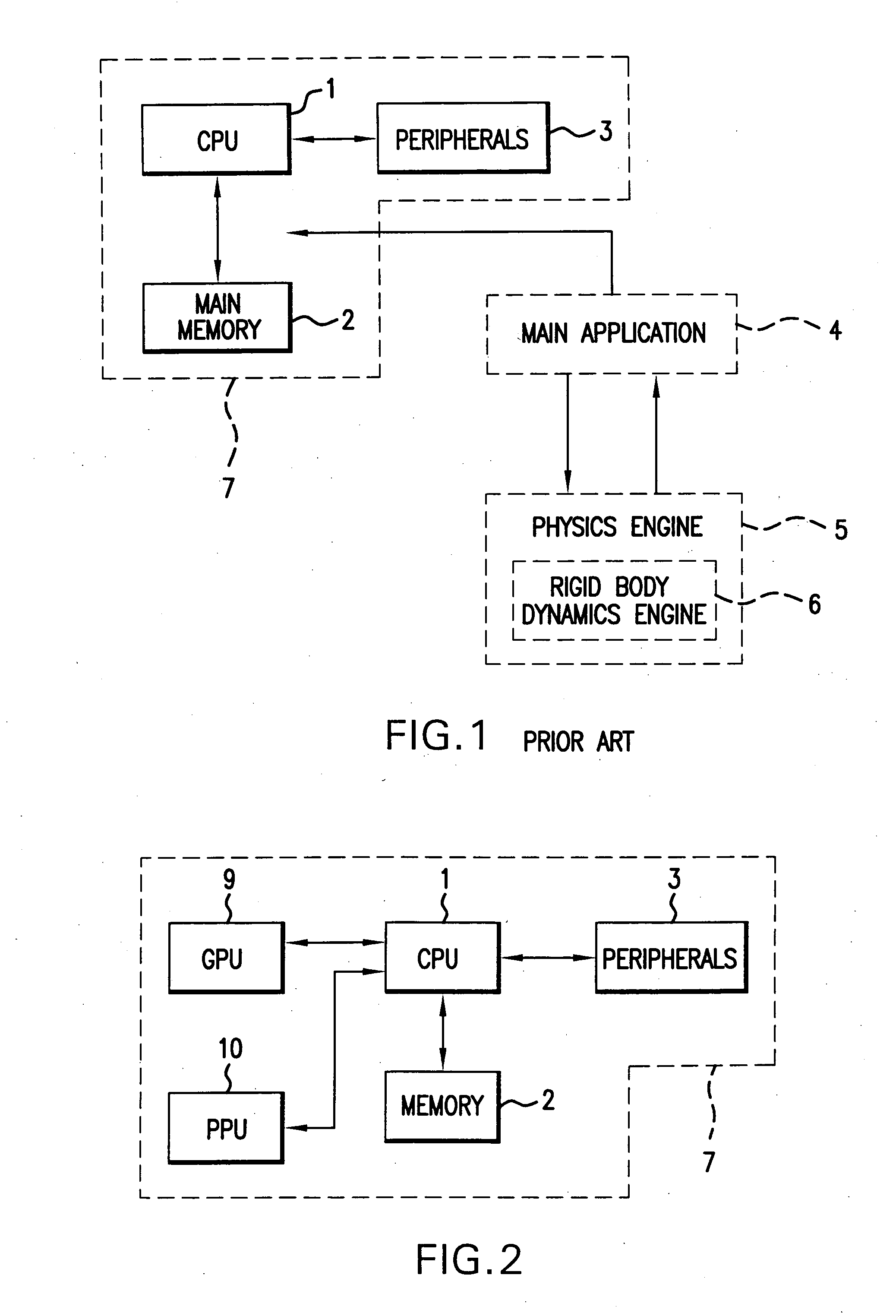Such problems arise, for example, during operation of a
rigid body dynamics engine within a system having a visual display.
If a simulator were to allow large penetrations of objects, then the illusion of object rigidity would be lost.
The practical development of physics-based animations, including
rigid body simulations, has proved quite difficult.
However, the set of cases which have algebraic solutions is very small and a rigid body simulator must be able to
handle any configuration of contacting rigid bodies.
Given that frames of
animation are only required at discrete time intervals, this is an acceptable limitation.
Selecting a discrete model that approximates a sufficiently large class of continuous problems and is solvable in real time by a computer is difficult.
A poor choice of discrete model can result in behavior that diverges unacceptably from the original continuous problem.
For example with a bad model, objects might jump around for no reason, penetrate unacceptably, fall through a floor, or fly off into infinity.
However, although this relaxed requirement makes it easier to meet the real-time constraint, it unfortunately doesn't make the mathematics any easier.
Solving the necessary
equations of motion to realistically animate objects has proved to be a difficult problem since accuracy (i.e., realism) and computational speed are always at
odds.
As well as being quite boring for the user, the
animation could not take into account the context of the action.
For example, if the user pressed the punch key next to a wall, there would often be nothing to stop the player's arm going through the wall.
If the user had previously parked a car behind the
pile of boxes, the boxes would typically fall through the car.
These problems were overcome conventionally by limiting the user's actions, for example by not giving the user a car to drive, not allowing the user to walk within arm's length of a wall and not allowing fights next to cliffs.
These restrictions were often frustrating to the user.
Thus, as game complexity increases the cost associated with the development of multiple animations becomes prohibitive.
As the
game design progresses, some additional constraints are added, however, as most fun games have some set of defining rules.
Unfortunately, contemporary physics engines have significant limitations as to the number of objects in an animated scene, and more particularly, the number of active (i.e., moving or interacting) objects.
Increasing complexity of
terrain geometry greatly increases the difficulty of simulating object interactions with the
terrain.
However, among the factors challenging the realistic, real-time
animation of objects in a physics-based application, the definition and incorporation of constraints upon the animated rigid body objects has proved most difficult.
Indeed, it the existence of numerous constraints that makes the underlying mathematical (numerical analysis) problem much more difficult to resolve, as compared with a simple application of Newton's laws of motion.
In mathematical terms, it is constraints upon the movement of objects within a physics-base problem that gives rise to many of the difficulties associated with solving the LCPs expressing the physics-based problem.
To date, however, these attempts have proved so slow that only relatively small physics-based problems have been successfully animated in real-time.
Once the number of the objects, forces, and / or constraints upon objects in a physics-based animation rises above a relatively small value, the mathematics underlying the animation simply can not be resolved in real-time using conventional computational methods and / or conventional hardware platforms.
While
general purpose processors, like the
Pentium family of microprocessors, are capable of executing
floating point operations, they are not able capable of executing the great number of floating operations typically required for the real-time animation of physics-based interactions.
This failure is really two-fold.
First, conventional computational methods are too inefficient to solve complex LCPs in real-time.
Second, conventional hardware platforms do not enable a the speed of data transfer and the number of mathematical operations required to animate complex physics-based interactions in real-time.
 Login to View More
Login to View More  Login to View More
Login to View More 


